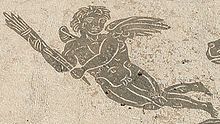Hymenaios

Cupid l. and Hymenaios r. sitting, r. on the edge the burning torch of Hymenaios on a Napoleonic wedding medal from 1807 . The medal was published to celebrate the wedding of Napoleon 's youngest brother Jérôme Bonaparte and Princess Catherine of Württemberg in Fontainebleau .
Hymenaios ( ancient Greek Ὑμέναιος , Latin Hymenaeus ), in German also Hymen for short , was the god of marriage in Greek mythology . His name came about as a personification of the song or shout Hymen o Hymenai, Hymen traditionally used in marriages within the context of the epithalamium .
myth
As a personification of the wedding song, Hymenaios appears for the first time in Pindar and Euripides . Although it was mythologically little developed, there are numerous variants of its origin: It is considered to be
- Son of Apollo and a muse (either Urania or Calliope )
- an Athenian youth who once followed a beloved virgin, whose parents refused him, dressed as a girl to Eleusis for the Demeter festival . There, however, he was kidnapped by robbers along with the maidens gathered there. Hymenaios, however, killed them when they slept drunk on the coast, which saved the girls
- Son of Bia and Kratos
- Son of Dionysus and Aphrodite
- an Argive boatman who protected Attic virgins from the raid of pirates.
presentation
In pictorial representations, Hymenaios is usually shown as a beautiful winged youth who wears a wedding torch , a saffron-yellow veil and a wreath of flowers , especially roses , or marjoram .
swell
- Ovid: Metamorphoses Book 10 1-7
literature
- Pascale Linant de Bellefonds: Hymenaios . In: Lexicon Iconographicum Mythologiae Classicae (LIMC). Volume IV, Zurich / Munich 1988, pp. 583-585.
- Pascale Linant de Bellefonds: Hyménaios: une iconographie contestée . In: Mélanges de l'Ecole française de Rome. Antiquité 103 (1991), pp. 197-212.
- Jan N. Bremmer : Hymenaios (1). In: The New Pauly (DNP). Volume 5, Metzler, Stuttgart 1998, ISBN 3-476-01475-4 , Col. 784 f.
- André Jolles : Hymen, Hymenaios. In: Paulys Realencyclopadie der classischen Antiquity Science (RE). Volume IX, 1, Stuttgart 1914, Col. 126-130.
- Bruno Sauer : Hymenaios . In: Wilhelm Heinrich Roscher (Hrsg.): Detailed lexicon of Greek and Roman mythology . Volume 1,2, Leipzig 1890, Col. 2800-2804 ( digitized version ).
- Herbert Hunger : Lexicon of Greek and Roman Mythology. Reinbek 1974, p. 186.
Web links
- Hymenaios in the Theoi Project (English)
